A Reciprocal-Selection-Based ‘Win–Win’ Overlay Spectrum-Sharing Scheme for Device-to-Device-Enabled Cellular Network
Abstract
:1. Introduction
1.1. Background
1.2. Related Work
1.3. Contributions and Paper Structure
- To improve QoS of EUs, EUs ask help from D2D pairs. EUs intend to share spectrum resource with D2D pairs in exchange of D2D pairs’ relaying data for them. However, how to allocate the spectrum resource between EUs and D2D pairs in overlay mode to achieve Win–Win?
- Compared to the underlay spectrum-sharing scheme, overlay spectrum-sharing scheme does not consider interference among users but reduces spectrum efficiency. Hence, how to improve spectrum efficiency in overlay spectrum-sharing scheme?
- A RSWW-OSSS is designed for a D2D-enabled cellular network in order to provide a better connective experience for EUs with the aid of cooperative communication. More explicitly, according to the proposed RSWW-OSSS, EUs are capable of achieving an increased rate with the aid of cooperation assistance provided by the D2D devices. Furthermore, in order to perform D2D transmission, the D2D devices intend to forward data for the EUs in exchange for accessing the part of cellular spectrum resource which is not used by the EUs.
- In order to improve the spectral efficiency, DTs employ the NOMA technology to simultaneously convey EUs’ and their own data at different transmit power. SIC is invoked at both the BS and D2D receivers (DRs) for separating the EUs’ and DTs’ data. As we know, NOMA technology is not introduced in overlay D2D cooperation communications in [19,20,21].
- Aiming for maximizing the utilities of both EU and D2D device, their behaviours are modelled as a two-stage Stackelberg game [31,32,33]. More explicitly, as the leader, EUs calculate the optimal time allocation coefficient in order to maximize its transmit rate. Furthermore, DTs are modelled as the followers which determine the optimal transmit powers for the cooperative transmission and D2D communication, in order to improve the achievable rate of D2D communication and simultaneously reduce the energy consumed for forwarding EUs’ data. The backward induction [34] is invoked for analysing the game and deriving the optimal strategies of EUs and DTs.
- For the sake of achieving a stable matching between multiple EUs and multiple D2D devices, we analyse the algorithmic stability of the proposed RSWW-OSSS with the aid of matching theory [35].
2. System Model
2.1. Construction and Assumption
2.2. Communication Model
2.2.1. Non-Cooperative Communication Model
2.2.2. Cooperative Communication Model
- PHASE 1: During the first time slot , the transmits data to and BS. The achievable rate of the direct transmission from the to the BS may be expressed as:Furthermore, the transmit rate achieved by the transmission from the to the may be expressed as:where represents the channel gain of the link from the to the .
- PHASE 2: During the second time slot , the simultaneously transmits ’s and itself data with the aid of NOMA technology. The transmits its own data to with the power of where , while forwards the ’s data with the power of where . Moreover, is power allocation coefficient. Equation (5) describes the data sent by the when the NOMA technology is employed.where is the ’s data which has to be forwarded by the , while denotes the ’s data. The total power consumed by the during the phase 2 is denoted by , which is equal to . The SIC technology is invoked at both the BS and the for the sake of separating ’s and ’s data. During phase 2, the Signal to Interference Plus Noise Ratio (SINR) of the ’s data received by the BS may be given by:where represents the channel gain of the link from the to the BS. Moreover, a represents the relationship between the power and . According to the NOMA and the SIC technologies, if forwards ’s data at a higher transmit power, namely , a is equal to 1. Otherwise, the value of a is 0, as shown in Equation (7).When the BS receives data from , SIC technology is exploited to separate the ’s and ’s data. Then, both the previous data from the in phase 1 and the later data from the in phase 2 are combined by the BS with the aid of Maximum Ratio Combining (MRC) [40,41]. The SINR of the merged data may be expressed as:After receiving the data from , separates the ’s and ’s data with the aid of SIC technology. The SINR of the ’s data may be expressed as:where represents the channel gain of the D2D link. Coefficient b represents the relationship between the power and , which may be given by:
3. Joint Cooperative Spectrum-Sharing Scheme
3.1. Utility of
3.2. Utility of
3.3. Analysis of the Proposed Two-Stage Stackelberg Game
3.3.1. ’s Strategy in Stage
3.3.2. ’s Strategy in Stage I
3.4. Matching Game for EUs and D2D Pairs
4. Simulation Results
Simulation Configuration
5. Conclusions
Author Contributions
Funding
Conflicts of Interest
Appendix A
Appendix B
References
- Poulakis, M.I.; Gotsis, A.G.; Alexiou, A. Multicell Device-to-Device Communication: A Spectrum-Sharing and Densification Study. IEEE Veh. Technol. Mag. 2018, 13, 85–96. [Google Scholar] [CrossRef] [Green Version]
- Ahmed, M.; Shi, H.; Chen, X.; Li, Y.; Waqas, M.; Jin, D. Socially Aware Secrecy-Ensured Resource Allocation in D2D Underlay Communication: An Overlapping Coalitional Game Scheme. IEEE Trans. Wirel. Commun. 2018, 17, 4118–4133. [Google Scholar] [CrossRef]
- Ghavami, H.; Moghaddam, S.S. Outage Probability for Underlaying Device to Device Communications. In Proceedings of the 2016 8th International Symposium on Telecommunications (IST), Tehran, Iran, 27–28 September 2016; pp. 353–358. [Google Scholar]
- Ferdouse, L.; Ejaz, W.; Raahemifar, K.; Anpalagan, A.; Markandaier, M. Interference and Throughput Aware Resource Allocation for Multi-class D2D in 5G Networks. IET Commun. 2017, 11, 1241–1250. [Google Scholar] [CrossRef]
- Ningombam, D.D.; Shin, S. Outage probability analysis of device-to-device communications with frequency reuse-2 in fractional frequency reuse method. In Proceedings of the 2018 International Conference on Information Networking (ICOIN), Chiang Mai, Thailand, 10–12 January 2018; pp. 341–345. [Google Scholar]
- Katsinis, G.; Tsiropoulou, E.E.; Papavassiliou, S. Joint Resource Block and Power Allocation for Interference Management in Device to Device Underlay Cellular Networks: A Game Theoretic Approach. Mob. Netw. Appl. 2017, 22, 539–551. [Google Scholar] [CrossRef]
- Ningombam, D.D.; Shin, S. Radio resource allocation and power control scheme to mitigate interference in device-to-device communications underlaying LTE-A uplink cellular networks. In Proceedings of the 2017 International Conference on Information and Communication Technology Convergence (ICTC), Jeju, South Korea, 18–20 October 2017; pp. 961–963. [Google Scholar]
- Ningombam, D.D.; Hwang, S.; Shin, S. A Novel Resource Sharing Mechanism for Device-to-Device Communications Underlaying LTE-A Uplink Cellular Networks. In Proceedings of the 2018 Tenth International Conference on Ubiquitous and Future Networks (ICUFN), Prague, Czech Republic, 3–6 July 2018; pp. 829–833. [Google Scholar]
- Katsinis, G.K.; Tsiropoulou, E.; Papavassiliou, S. On the Performance Evaluation of Distributed Resource Block and Power Allocation in D2D-enabledd Multi-Cell Networks. In Proceedings of the 14th ACM Symposium on Performance Evaluation of Wireless Ad Hoc, Sensor & Ubiquitous Networks, Montevideo, Uruguay, 10–14 April 2017; pp. 77–84. [Google Scholar]
- Ningombam, D.D.; Hwang, S.; Shin, S. Overlay Inband D2D-e Network Using Fuzzy C-Means Clustering for Disaster Situations. In Proceedings of the 2018 European Conference on Networks and Communications (EuCNC), Ljubljana, Slovenia, 18–21 June 2018; pp. 288–292. [Google Scholar]
- Kiwan, D.; El Sherif, A.; El Batt, T. Cooperative D2D communications in the uplink of cellular networks with time and power division. In Proceedings of the 2018 Wireless Days (WD), Dubai, United Arab Emirates, 3–5 April 2018; pp. 80–85. [Google Scholar]
- Klaiqi, B.; Chu, X.; Zhang, J. Energy-and Spectral-Efficient Adaptive Forwarding Strategy for Multi-Hop Device-to-Device Communications Overlaying Cellular Networks. IEEE Trans. Wirel Commun. 2018, 17, 5684–5699. [Google Scholar] [CrossRef]
- Yuan, Y.; Yang, T.; Xu, Y.; Hu, B. Cooperative spectrum-sharing between D2D Users and Edge-Users: A Matching Theory Perspective. In Proceedings of the 2016 IEEE 27th Annual International Symposium on Personal, Indoor, and Mobile Radio Communications (PIMRC), Valencia, Spain, 4–8 September 2009; pp. 1–6. [Google Scholar]
- Dinh-Van, S.; Duong, Q.; Shin, O.-S. User Grouping for Device-to-Device Communications Underlaying Cellular Networks. In Proceedings of the 2014 IEEE 11th Consumer Communications and Networking Conference (CCNC), Las Vegas, NV, USA, 10–13 January 2014; pp. 563–568. [Google Scholar]
- Moualeu, J.M.; Hamouda, W.; Takawira, F. Cognitive Coded Cooperation in Underlay Spectrum-Sharing Networks Under Interference Power Constraints. IEEE Trans. Veh. Technol. 2017, 66, 2099–2113. [Google Scholar] [CrossRef]
- Ma, C.; Li, Y.; Yu, H.; Gan, X.; Wang, X.; Ren, Y.; Xu, J.J. Cooperative spectrum-sharing in D2D-enabledd Cellular Networks. IEEE Trans. Commun. 2016, 64, 4394–4408. [Google Scholar]
- Yang, L.; Wu, D.; Cai, Y. Social Aware Joint Link and Power Allocation for D2D Communication Underlaying Cellular Networks. IET Commun. 2018, 12, 493–500. [Google Scholar] [CrossRef]
- Fan, L.; Dong, Z.; Yuan, P. The Capacity of Device-to-Device Communication Underlaying Cellular Networks with Relay Links. IEEE Access 2017, 11, 1241–1250. [Google Scholar] [CrossRef]
- Swetha, G.D.; Murthy, G.R. Selective Overlay Mode Operation for D2D Communication in Dense 5G Cellular Networks. In Proceedings of the 2017 IEEE Symposium on Computers and Communications (ISCC), Heraklion, Greece, 3–6 July 2017; pp. 704–709. [Google Scholar]
- Li, J.C.F.; Lei, M.; Gao, F. Device-to-device (D2D) Communication in MU-MIMO Cellular Networks. In Proceedings of the 2012 IEEE Global Communications Conference (GLOBECOM), Anaheim, CA, USA, 3–7 December 2012; pp. 3583–3587. [Google Scholar]
- Cao, Y.; Jiang, T.; Wang, C. Cooperative Device-to-Device Communications in Cellular Networks. IEEE Wirel. Commun. 2015, 22, 124–129. [Google Scholar] [CrossRef]
- Yang, Z.; Xu, W.; Pan, C.; Pan, Y.; Chen, M. On the Optimality of Power Allocation for NOMA Downlinks with Individual QoS Constraints. IEEE Commun. Lett. 2017, 21, 1649–1652. [Google Scholar] [CrossRef]
- Gendia, A.H.; Elsabrouty, M.; Emran, A.A. Cooperative Multi-Relay Non-Orthogonal Multiple Access for Downlink Transmission in 5G Communication Systems. In Proceedings of the 2017 Wireless Days, Porto, Portugal, 29–31 March 2017; pp. 89–94. [Google Scholar]
- Zhang, Z.; Ma, Z.; Xiao, M.; Ding, Z.; Fan, P. Full-Duplex Device-to-Device-Aided Cooperative Nonorthogonal Multiple Access. IEEE Trans. Veh. Technol. 2017, 66, 4467–4471. [Google Scholar]
- Zhao, J.; Liu, Y.; Chai, K.K.; Che, Y.; Elkashlan, M.; Alonso-Zarate, J. NOMA-Based D2D Communications: Towards 5G. In Proceedings of the 2016 IEEE Global Communications Conference (GLOBECOM), Washington, DC, USA, 4–8 December 2016; pp. 1–6. [Google Scholar]
- Aldawsari, B.; Baker, T.; England, D. Trusted Energy-Efficient Cloud-Based Services Brokerage Platform. Int. J. Intell. Comput. Res. (IJICR) 2015, 6, 630–639. [Google Scholar] [CrossRef]
- Baker, T.; Ngoko, Y.; Tolosana-Calasanz, R.; Rana, O.F.; Randles, M. Energy Efficient Cloud Computing Environment Via Autonomic Meta-Director Framework. In Proceedings of the 2013 Sixth International Conference on Developments in Systems Engineering, Abu Dhabi, United Arab Emiratesa, 16–18 December 2013; pp. 198–203. [Google Scholar]
- Baker, T.; García-Campos, J.M.; Reina, D.G.; Toral, S.; Tawfik, H.; Al-Jumeil, D.; Hussain, A. GreeAODV: An Energy Efficient Routing Protocol for Vehicular Ad Hoc Networks. In Proceedings of the ICIC 2018: Intelligent Computing Methodologies, Wuhan, China, 15–18 August 2018; pp. 670–681. [Google Scholar]
- Baker, T.; Asim, M.; Tawfik, H.; Aldawsari, B.; Buyya, R. An energy-aware service composition algorithm for multiple cloud-based IoT applications. J. Netw. Comput. Appl. 2017, 89, 96–108. [Google Scholar] [CrossRef]
- Niu, Y.; Liu, Y.; Li, Y.; Chen, X.; Zhong, Z.; Han, Z. Device-to-Device Communications Enabled Energy Efficient Multicast Scheduling in mmWave Small Cells. IEEE Trans. Commun. 2018, 66, 1093–1109. [Google Scholar] [CrossRef] [Green Version]
- Ahmad, I.; Feng, Z.; Hameed, A.; Zhang, P.; Zhao, Y. Spectrum-sharing and Energy-Efficient Power Optimization for Two-tier Femtocell Networks. In Proceedings of the 2014 9th International Conference on Cognitive Radio Oriented Wireless Networks and Communications (CROWNCOM), Oulu, Finland, 2–4 June 2014; pp. 156–161. [Google Scholar]
- Ali, R.E.; Seddik, K.G.; Nafie, M.; Digham, F.F. A Pricing-Based Cooperative spectrum-sharing Stackelberg Game. In Proceedings of the 2014 12th International Symposium on Modeling and Optimization in Mobile, Ad Hoc, and Wireless Networks (WiOpt), Hammamet, Tunisia, 12–16 May 2014; pp. 226–232. [Google Scholar]
- Yin, R.; Yu, G.; Zhong, C.; Zhang, Z. Distributed Resource Allocation for D2D Communication Underlaying Cellular Networks. In Proceedings of the 2013 IEEE International Conference on Communications Workshops (ICC), Budapest, Hungary, 9–13 June 2013; pp. 138–143. [Google Scholar]
- Mas-Colell, A.; Whinston, M.D.; Green, J.R. Microeconomic Theory; Publishing House of Oxford University Press: Oxford, UK, 1995. [Google Scholar]
- Errapotu, S.M.; Wang, J.; Li, X.; Lu, Z.; Li, W.; Pan, M.; Han, Z. Bid Privacy Preservation in Matching-Based Multiradio Multichannel Spectrum Trading. IEEE Trans. Veh. Technol. 2018, 67, 8336–8347. [Google Scholar] [CrossRef]
- Wu, Q.; Li, G.Y.; Chen, W.; Ng, D.W.K. Energy-Efficient D2D Overlaying Communications with Spectrum-Power Trading. IEEE Trans. Wirel. Commun. 2017, 16, 4401–4419. [Google Scholar] [CrossRef]
- Katsinis, G.; Tsiropoulou, E.E.; Papavassiliou, S. Multicell Interference Management in Device to Device Underlay Cellular Networks. Future Internet 2017, 9, 44. [Google Scholar] [CrossRef]
- Asadi, A.; Wang, Q.; Mancuso, V. A Survey on Device-to-Device Communication in Cellular Networks. IEEE Commun. Surv. Tutor. 2014, 16, 1801–1819. [Google Scholar] [CrossRef] [Green Version]
- Feng, D.; Lu, L.; Wu, Y.Y.; Li, G.Y.; Feng, G.; Li, S. Optimal Resource Allocation for Device-to-Device Communications in Fading Channels. In Proceedings of the 2013 IEEE Global Communications Conference (GLOBECOM), Atlanta, GA, USA, 9–13 December 2013; pp. 3673–3678. [Google Scholar]
- Guo, Q.; Yu, L. An Outage-Optimal Distributed Coded Cooperation Scheme Based on Opportunistic Relaying. In Proceedings of the 2009 IEEE Wireless Communications and Networking Conference, Budapest, Hungary, 5–8 April 2009; pp. 1–5. [Google Scholar]
- Chen, B.; Chen, Y.; Chen, Y.; Cao, Y.; Zhao, N.; Ding, Z. A Novel spectrum-sharing Scheme Assisted by Secondary NOMA Relay. IEEE Wirel. Commun. Lett. 2018, 7, 732–735. [Google Scholar] [CrossRef]
- Chu, Z.; Le, T.A.; Nguyen, H.X.; Nallanathan, A.; Karamanoglu, M. A Stackelberg-Game Approach for Disaster-Recovery Communications Utilizing Cooperative D2D. IEEE Access. 2018, 6, 10733–10742. [Google Scholar] [CrossRef]
- Han, Y.; Tao, X.; Zhang, X. Power allocation for device-to-device underlay communication with femtocell using stackelberg game. In Proceedings of the 2018 IEEE Wireless Communications and Networking Conference (WCNC), Barcelona, Spain, 15–18 April 2018; pp. 1–6. [Google Scholar]
- Chong, E.K.P.; Zak, S.H. An Introduction to Optimization, 4th ed.; Sun, Q., Bai, J., Eds.; Publishing House of Electronics Industry: Beijing, China, 2015; ISBN 9787121267154. [Google Scholar]
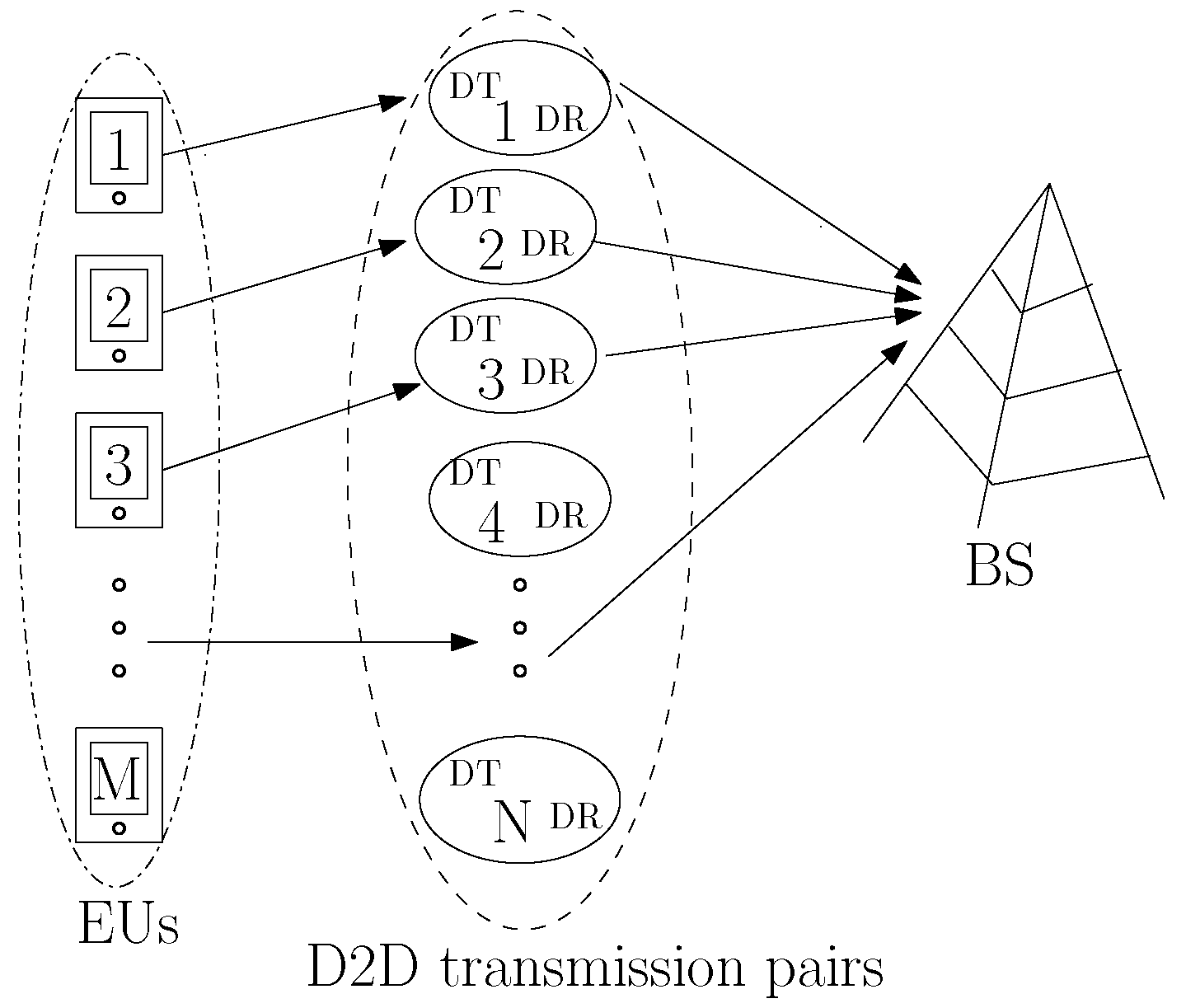
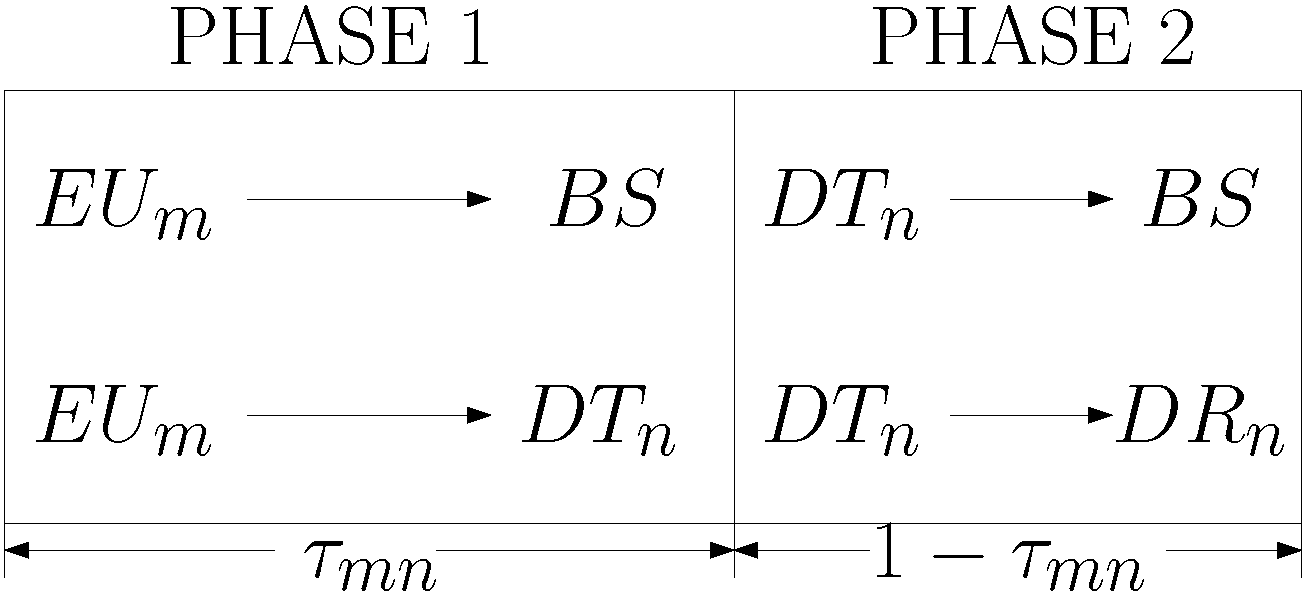
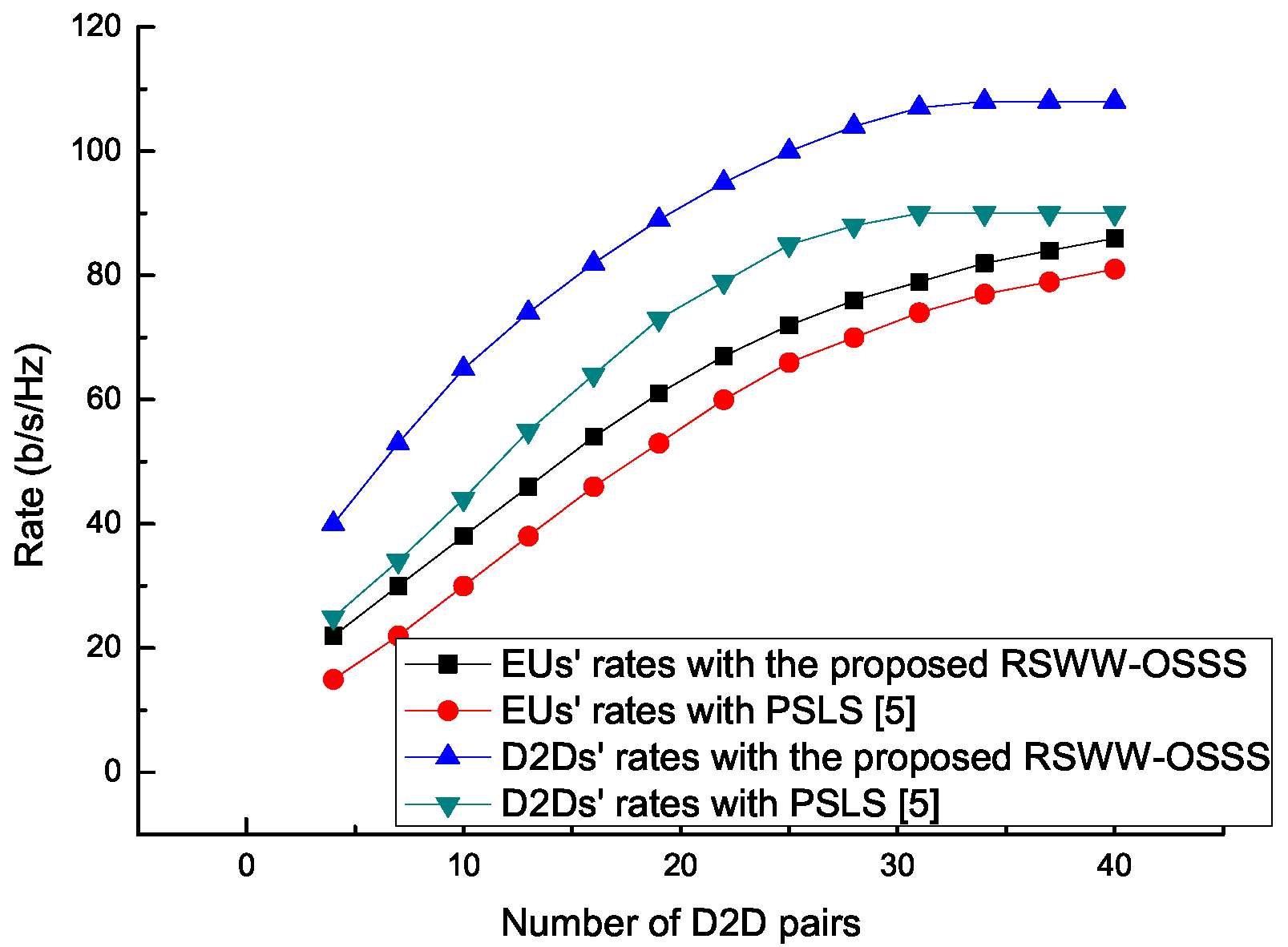

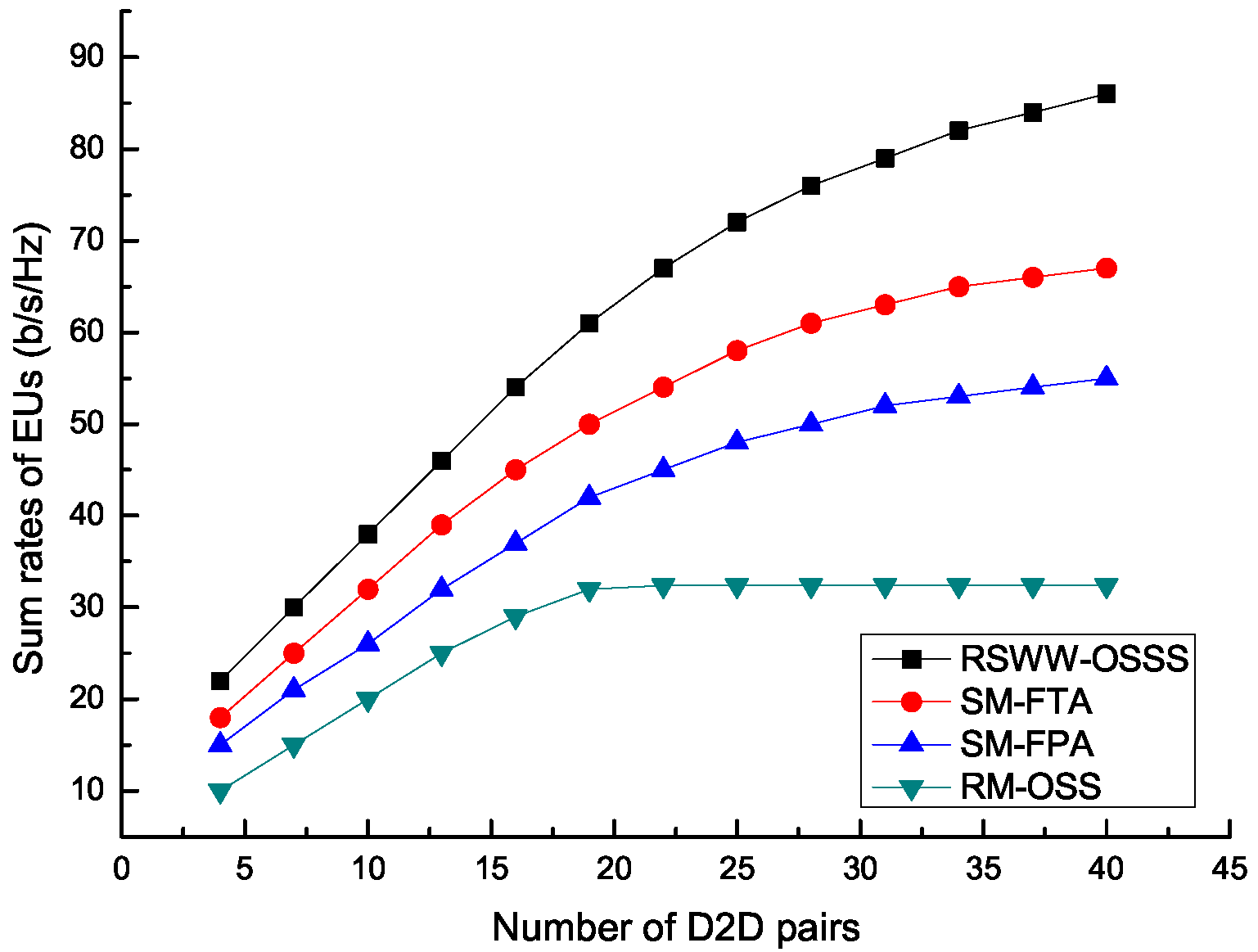
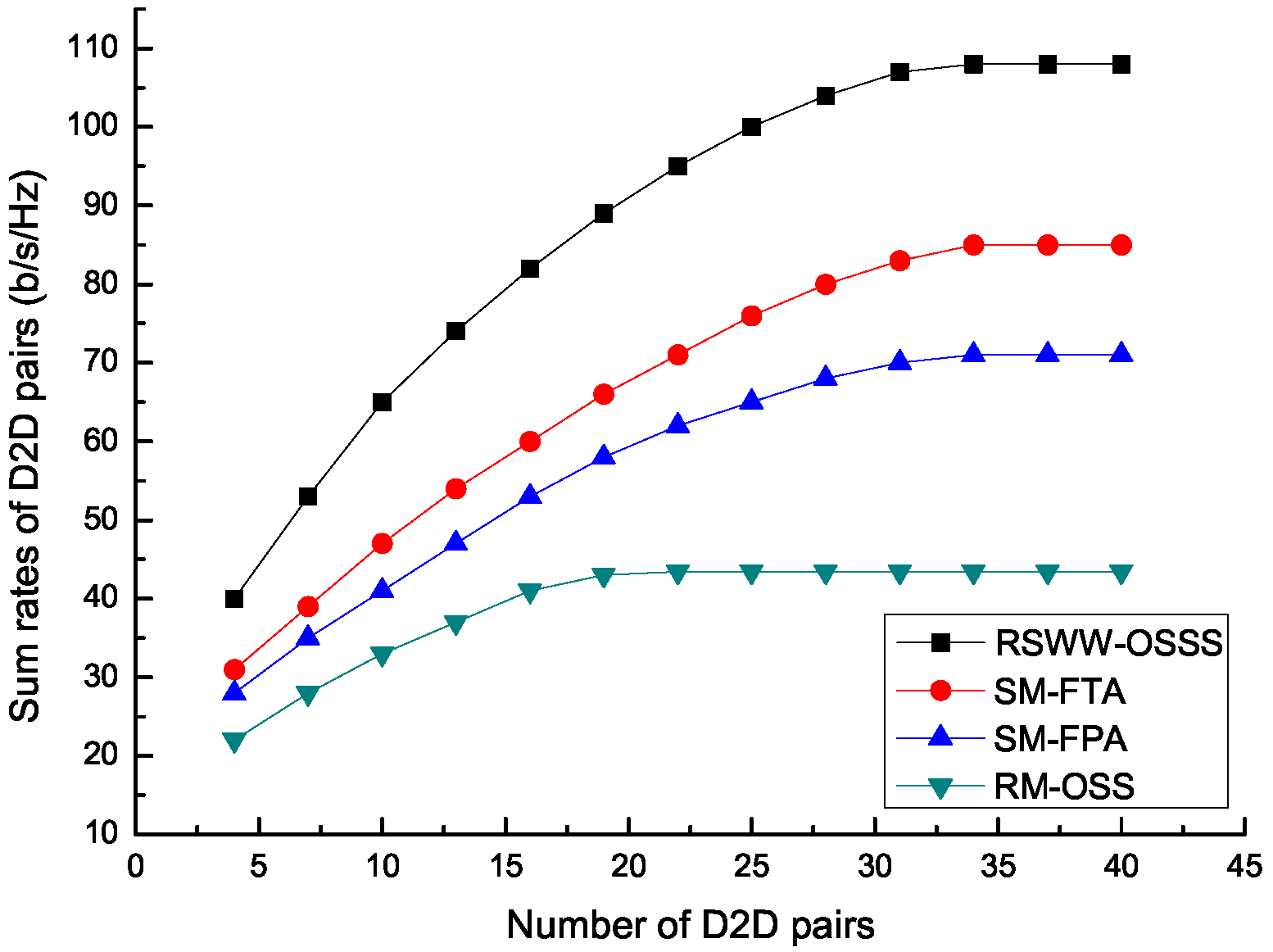
| Notation | Physical Meaning |
|---|---|
| ’s transmit power | |
| ’s transmit power | |
| EUs’ and DTs’ maximum transmit power | |
| channel gain between and | |
| channel gain between and BS | |
| channel gain between and | |
| channel gain between and BS | |
| power of AWGN |
| Require |
|---|
| Let and exchange their profile information. |
| ’s Strategy in Stage : |
| ▹ Given the time allocation coefficient offered by the in Stage . |
| ▹ calculates the optimal power allocation coefficient according Equation (18) |
| ’s strategy in Stage : |
| ▹ Given the optimal power allocation coefficient which is shown in Equation (18) |
| ▹ calculates the optimal power allocation coefficient which is the solution of Equation (24) |
| () is the Nash Equilibrium of the proposed two-stage Stackelberg game. |
| Initialization: |
|---|
| Let and be the preference list of and respectively. |
| Repeat: |
| for all do |
| if is not matched |
| ▹ broadcasts proposal to favourable according to . |
| Set , . |
| while and for |
| ▹. |
| if in the preference list of |
| if is not matched |
| ▹ accepts the proposal , set . |
| if is matched with |
| if |
| ▹ rejects the former and accepts the proposal of , set . |
| else |
| ▹ set . |
| for all do |
| if achieves more than one proposal |
| ▹ selects the one who requires lower transmit power. |
| for all do |
| if is already matched with |
| if divorces matched pair |
| ▹ is not matched. |
| Until: Each EU are either assigned to one of the D2D pairs or rejected by all of D2D pairs in . |
| Parameters | Value |
|---|---|
| 500 m | |
| −114 dBm | |
| 50 m | |
| 100 mW | |
| 100 mW | |
| 4 | |
| 2.5 | |
| 20 |
© 2018 by the authors. Licensee MDPI, Basel, Switzerland. This article is an open access article distributed under the terms and conditions of the Creative Commons Attribution (CC BY) license (http://creativecommons.org/licenses/by/4.0/).
Share and Cite
Li, P.; Shu, C.; Feng, J. A Reciprocal-Selection-Based ‘Win–Win’ Overlay Spectrum-Sharing Scheme for Device-to-Device-Enabled Cellular Network. Algorithms 2018, 11, 179. https://doi.org/10.3390/a11110179
Li P, Shu C, Feng J. A Reciprocal-Selection-Based ‘Win–Win’ Overlay Spectrum-Sharing Scheme for Device-to-Device-Enabled Cellular Network. Algorithms. 2018; 11(11):179. https://doi.org/10.3390/a11110179
Chicago/Turabian StyleLi, Peng, Chenchen Shu, and Jiao Feng. 2018. "A Reciprocal-Selection-Based ‘Win–Win’ Overlay Spectrum-Sharing Scheme for Device-to-Device-Enabled Cellular Network" Algorithms 11, no. 11: 179. https://doi.org/10.3390/a11110179
APA StyleLi, P., Shu, C., & Feng, J. (2018). A Reciprocal-Selection-Based ‘Win–Win’ Overlay Spectrum-Sharing Scheme for Device-to-Device-Enabled Cellular Network. Algorithms, 11(11), 179. https://doi.org/10.3390/a11110179





